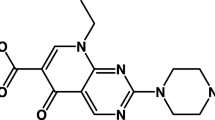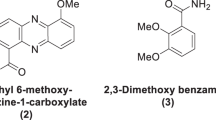Abstract
Eight 4-quinazolylhydrazines and eleven their arylhydrazones have been tested for antibacterial effects and for structure-activity relationships by a modifed microdilution method. The derivative 6-chloro-2-morpholino-4-quinazolyl-5′-nitro-2′-furylhydrazone had the highest antibacterial effect, the MIC values being 100 mg/L forE. fœcalis, 250 mg/L forS. aureus, 200 mg/L forP. aeruginosa and 350 mg/L forE. coli. The most effective derivatives were those with the benzene ring substituted with chlorine or methyl group in position 6 or 8 and with pyrimidine ring substituted with a secondary amine in position 2. The modified microdilution method did not give rise to any statistically significant deviations in the MIC values for ampicillin in comparison with reported reference collection values.
Similar content being viewed by others
References
Jantová S., Hudecová D., Špirková K., Stankovský Š.: Structure-activity relationships of some 4-quinazolylthiosemi-carbazides and their triazolo derivatives.Folia Microbiol. 39, 471–474 (1994).
Kneiflová J.: Assessment of the bactericidal efficiency of disinfectants by a suspension micromethod. (In Czech)Čs. epidemiol. mikrobiol. immunol. 37, 97–107 (1988).
Kottke K., Kühmstedt H.: Über die Darstellung von 2-Hydrazino-3-arylchinazolonen-(4)-Synthese von Verbindungen mit Aminoguanidinstruktur.Pharmazie 33, 19–23 (1978).
Omar A.M.E., El-Dine S.A.S., Ghobasy A.A., Khalil M.A.: Synthesis of some novel quinazoline thiosemicarbazide and thiazoline derivatives for potential antimicrobial activity.Eur. J. Med. Chem.-Clin. Therapeut. 16, 77–80 (1981).
Saksena R.K., Amin Khan M.: Synthesis of 2-alkyl/aryl-3-arylhydrazino-quinazolin-4(3H)-ones as antibacterial and CNS active agents.Indian J. Chem. 28, 443–444 (1989).
Stankovský Š., Sokyrová M.: Amidinoyl isothiocyanates in the synthesis of condensed quinazolines. Preparation ofs-triazolo-[4,3-c]quinazolines.Coll. Czech. Chem. Commun. 49, 1795–1799 (1984).
Špirková K., Horňaček J., Stankovský Š.: Amidinoyl isothiocyanates in the synthesis of condensed quinazolines. Preparation of 3-aryl-9-chloro-5-morpholino(1,2,4)triazolo-[4,3-c]quinazolines and their [1,5-c] isomers.Chem. Papers 47, 382–385 (1994).
Špirková K., Stankovský Š., Horňaček J.: Preparation ofs-triazolo[4,3-c]quinazolines.Coll. Czech. Chem. Commun. 59, 243–246 (1994).
Author information
Authors and Affiliations
Additional information
Dedicated to Professor Vladimír Betina, DSc. on the occasion of his 65th birthday
Rights and permissions
About this article
Cite this article
Jantová, S., Hudecová, D., Stankovský, Š. et al. Antibacterial effect of substituted 4-quinazolylhydrazines and their arylhydrazones determined by a modified microdilution method. Folia Microbiol 40, 611–614 (1995). https://doi.org/10.1007/BF02818517
Received:
Issue Date:
DOI: https://doi.org/10.1007/BF02818517




